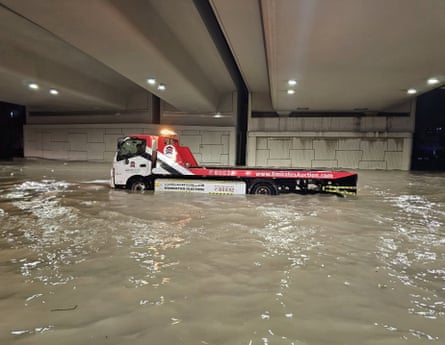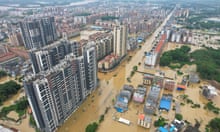Highways and malls have been flooded, schools have been closed, and flights disrupted at one of the world’s busiest airports after the United Arab Emirates experienced what the government described as its largest amount of rainfall in 75 years.
At least one person was killed, a 70-year-old man who police said was swept away in his car in Ras Al Khaimah, one of the UAE’s seven emirates.
Footage from Dubai international airport showed passenger jets moving through deep water, spraying water in their wake, while photos captured city streets turned to rivers, with cars sitting abandoned in flood waters.
One man called the situation at the airport “absolute carnage”.
“You cannot get a taxi. There’s people sleeping in the metro station. There’s people sleeping in the airport,” the man told Associated Press on condition of anonymity in a country with strict laws that criminalise critical speech.
Despite the widespread impact, authorities have remained tight-lipped on the extent of the damage.
The rains began on Monday night and by Tuesday evening more than 142mm (5.59in) had soaked the desert city of Dubai – normally the amount it gets in a year and a half.
Heavy rain also fell in Bahrain, Qatar, Saudi Arabia and Oman, where rescuers found the body of a girl in Saham, bringing the death toll in the country to 19 since Sunday.
In an average year, there is 94.7mm (3.73in) of rain at Dubai international airport, the world’s busiest for international travel and a hub for the long-haul carrier Emirates. On Wednesday, it said it had experienced “significant disruption”.
EgyptAir suspended flights between Cairo and Dubai until the conditions improve.
Paul Griffiths, the airport’s CEO, said the situation remained incredibly challenging. “In living memory, I don’t think anyone has ever seen conditions like it,” he told the state-owned talk radio station Dubai Eye. “We are in uncharted territory.”
Some media reports suggested the rains may have been made worse by cloud seeding, a common practice in the dry Emirates to encourage clouds to produce precipitation by releasing salt particles into the air, often using planes. The salt released in cloud-seeding operations helps water droplets to form, increasing the chance of rain.
However, the National Center of Meteorology (NCM), which oversees cloud-seeding operations in the UAE, told CNBC that no missions had been dispatched for seeding operations before or during the turbulent weather episode.
Omar Al Yazeedi, the deputy director general of the NCM, said: “We did not engage in any seeding operations during this particular weather event. The essence of cloud seeding lies in targeting clouds at an earlier stage, prior to precipitation. Engaging in seeding activities during a severe thunderstorm scenario would prove futile.”
Maarten Ambaum, a professor of atmospheric physics and dynamics at the University of Reading, said he had spoken to meteorologists at the NCM who had denied cloud seeding had taken place.
“Cloud seeding, certainly in the Emirates, is used for clouds that don’t normally produce rain … You would not normally develop a very severe storm out of that,” he said, adding that it would be “totally pointless” to try to seed clouds that were already likely to produce downpours. “Even if you did go out, there is no way you could find a measurable difference.”
He added: “In the 50s and 60s, people still thought about using cloud seeding to produce these big weather events, or change these big weather events. This [has] long been recognised as just not a realistic possibility.”
Rain is unusual in the UAE but occurs periodically during the cooler winter months.
Homes were flooded and vehicles were abandoned on roadways across Dubai, and authorities sent tanker trucks into the streets to pump away the water. Many roads and other areas lack drainage given the rarity of regular rainfall.
شاهد.. ارتفاع منسوب المياه بمطار #دبي#منخفض_الهدير pic.twitter.com/8gswSzbJKJ
— العربية الإمارات (@AlArabiyaUAE) April 16, 2024
The major shopping centres Dubai Mall and Mall of the Emirates experienced flooding, and there was ankle-deep water in at least one Dubai Metro station, according to images posted on social media.
Lightning was seen flashing across the sky, occasionally touching the tip of the Burj Khalifa, the world’s tallest building.

The NCM in a post on X urged residents to “take all the precautions … and to stay away from areas of flooding and water accumulation”.
The UAE government media office posted on X that the downpours were an “exceptional” climate event.
صور الرادار ثلاثية الأبعاد لحركة تكون السحب#أمطار #أمطار_الخير#المركز_الوطني_للأرصاد
— المركز الوطني للأرصاد (@ncmuae) April 16, 2024
3D Radar images of cloud formation over the area
#rain#national_Center_of_Meteorology pic.twitter.com/NBYkFL1Gsn
Schools will remain closed in Dubai until next week, authorities said, underscoring the difficulty of the clean-up, and the government extended remote working for its employees.
The weather system had already caused floods across Bahrain and left 19 people dead in Oman, including 10 schoolchildren swept away in a vehicle.
Human-caused climate breakdown is supercharging extreme weather across the world, driving more frequent and more deadly disasters from heatwaves and wildfire to floods. At least a dozen of the most serious events of the last decade would have been all but impossible without human-caused global heating.

Extreme rainfall is more common and more intense because of human-caused climate breakdown across most of the world. This is because warmer air can hold more water vapour. It is most likely that flooding has become more frequent and severe as a result.
Ambaum said the world should expect more extreme weather events. He said: “We have been saying for several decades now that in a changing climate we will probably get more of these kinds of severe events, and indeed this is happening.”
Associated Press and Agence France-Presse contributed to this report









